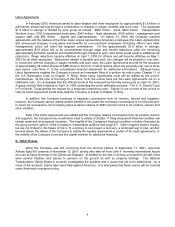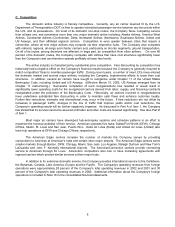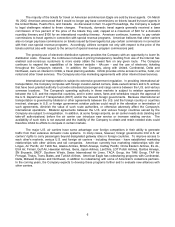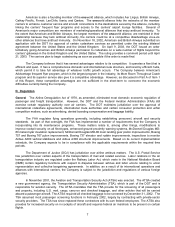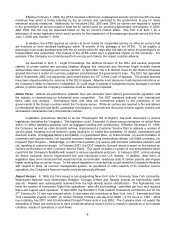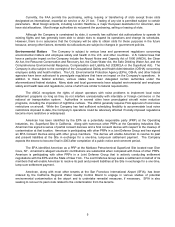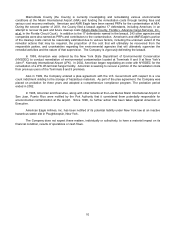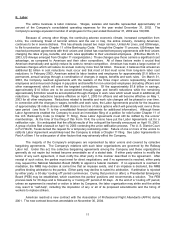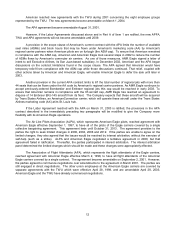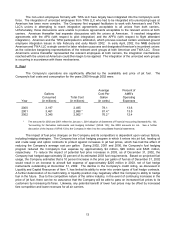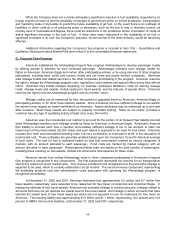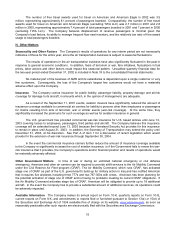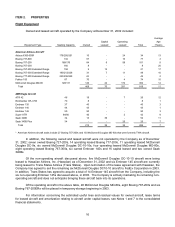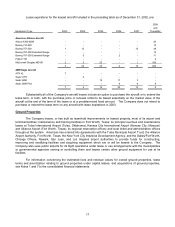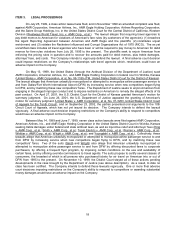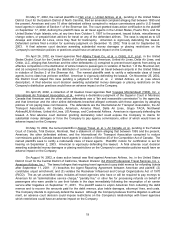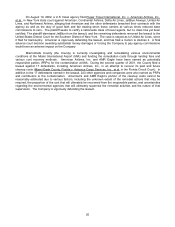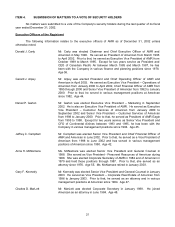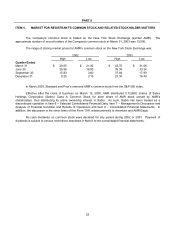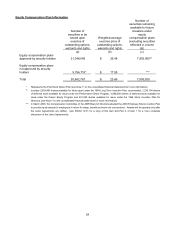American Airlines 2002 Annual Report Download - page 16
Download and view the complete annual report
Please find page 16 of the 2002 American Airlines annual report below. You can navigate through the pages in the report by either clicking on the pages listed below, or by using the keyword search tool below to find specific information within the annual report.
14
While the Company does not currently anticipate a significant reduction in fuel availability, dependency on
foreign imports of crude oil and the possibility of changes in government policy on jet fuel production, transportation
and marketing make it impossible to predict the future availability of jet fuel. In the event there is an outbreak of
hostilities or other conflicts in oil producing areas or elsewhere, such as the war in Iraq or domestic turmoil, as
recently seen in Venezuela and Nigeria, there could be reductions in the production and/or importation of crude oil
and/or significant increases in the cost of fuel. If there were major reductions in the availability of jet fuel or
significant increases in its cost, the Company's business, as well as that of the entire industry, would be adversely
affected.
Additional information regarding the Company’s fuel program is included in Item 7(A) – Quantitative and
Qualitative Disclosures about Market Risk and in Note 9 to the consolidated financial statements.
G. Frequent Flyer Program
American established the AAdvantage frequent flyer program (AAdvantage) to develop passenger loyalty
by offering awards to travelers for their continued patronage. AAdvantage members earn mileage credits for
flights on American, American Eagle and certain other participating airlines, or by using services of other program
participants, including bank credit card issuers, hotels and car rental and phone service companies. American
sells mileage credits and related services to the other companies participating in the program. American reserves
the right to change the AAdvantage program rules, regulations, travel awards and special offers at any time without
notice. American may initiate changes impacting, for example, participant affiliations, rules for earning mileage
credit, mileage levels and awards, limited seating for travel awards, and the features of special offers. American
reserves the right to end the AAdvantage program with six months’ notice.
Mileage credits can be redeemed for free, discounted or upgraded travel on American, American Eagle or
participating airlines, or for other travel industry awards. Once a member accrues sufficient mileage for an award,
the member may request an award certificate from American. Award certificates may be redeemed up to one year
after issuance. Most travel awards are subject to capacity controlled seating. Miles do not expire, provided a
customer has any type of qualifying activity at least once every 36 months.
American uses the incremental cost method to account for the portion of its frequent flyer liability incurred
when AAdvantage members earn mileage credits by flying on American or American Eagle. American's frequent
flyer liability is accrued each time a member accumulates sufficient mileage in his or her account to claim the
lowest level of free travel award (25,000 miles) and such award is expected to be used for free travel. American
includes fuel, food, and reservations/ticketing costs, but not a contribution to overhead or profit, in the calculation of
incremental cost. These estimates are generally updated based upon the Company’s 12-month historical average
of such costs. The cost for fuel is estimated based on total fuel consumption tracked by various categories of
markets, with an amount allocated to each passenger. Food costs are tracked by market category, with an
amount allocated to each passenger. Reservation/ticketing costs are based on the total number of passengers,
including those traveling on free awards, divided into American's total expense for these costs.
Revenue earned from selling AAdvantage miles to other companies participating in American’s frequent
flyer program is recognized in two components. The first component represents the revenue for air transportation
sold and is valued at current market rates. This revenue is deferred and recognized over the period the mileage is
expected to be used, which is currently estimated to be 28 months. The second revenue component, representing
the marketing products sold and administrative costs associated with operating the AAdvantage program, is
recognized immediately.
At December 31, 2002 and 2001, American estimated that approximately 9.3 million and 8.7 million free
travel awards, respectively, were expected to be redeemed for free travel on American and American Eagle. In
making the estimate of free travel awards, American has excluded mileage in inactive accounts, mileage related to
accounts that have not yet reached the lowest level of free travel award, and mileage in active accounts that have
reached the lowest level of free travel award but which are not expected to ever be redeemed for free travel on
American. The resulting liability was approximately $1.2 billion and $1.1 billion, representing 16.2 percent and 14.9
percent of AMR's total current liabilities, at December 31, 2002 and 2001, respectively.


